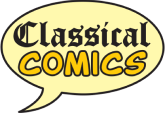Captions, sound effects, signs, display letters and speech balloons are last to be added to a graphic novel after pencillers, inkers and colourists are finished but they are far from an afterthought. At the earliest rough sketching stage our graphic artists need to consider and leave enough space for our letterers to add speech balloons and lettering (and this is especially true for some of Shakespeare's more epic speeches). Characters and important panel artwork could be covered up unnecessarily if consideration isn’t given to the amount of speech that needs to fit into a panel very early on in the production process.
By leaving enough space for text in our unabridged versions of Shakespeare’s plays, our Quick Text versions, in comparison, show much more of the artwork in each panel as there are smaller or fewer speech balloons needed once the dialogue is reduced. This can be seen in this panel comparison of Original, Plain and Quick Text from Henry V The Graphic Novel:
Accurate placement of balloons is important too. We try not to cover figures but instead opt to cover the less important background or empty space in a panel. Speech balloons can overlap to save space but balloon tails shouldn’t. Balloon tails should point to the mouth of the speaker - or at least towards their head and be a consistent length throughout the book.
Lettering and sound effects can help to capture the emotion and drama of a scene. This can be achieved with stylised fonts, which can enhance the whole graphic novel experience too. Sound effects should look like they emanate from the source of the sound and be dynamic.
In our aim to make the classics relevant, accessible and fun we choose letterers whose style we know will compliment the book artwork. Here we see Jim Campbell's letters on page 115 of our unabridged Romeo & Juliet graphic novel: Juliet's father Lord Capulet in an absolute rage when he finds out Juliet refuses to marry Paris. The book artwork and lettering works brilliantly together to convey this.

For graphic novels to be easy to read, it should be clear what the reading order is. Words in speech balloons should be legible. Typically comic lettering is all upper case. Aesthetically this allows the lines of type to sit in the speech balloons better as they can sit closer (without having to consider the ascenders and descenders that lower case letters have). We know upper and lowercase is the preferred reading format for some groups who find reading difficult but for the large amount of unabridged text that need to fit in speech balloons, lowercase letters take up too much space when used at a legible size to fit our graphic novel format.
The fonts we choose for each of our graphic novels are important too. They are stylised for the character and their speech. The monster in our Frankenstein graphic novel, the ghosts who visit Ebenezer Scrooge in A Christmas Carol and the French Queen in Henry V are all examples of specific fonts chosen to suit their characters’ speech.



If you’d like to have a go at lettering there are a few downloadable ‘No Text’ pages from a selection of our Shakespeare titles here. These have empty speech balloons for you to fill in the dialogue, so why not give it a try.

